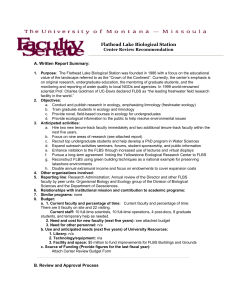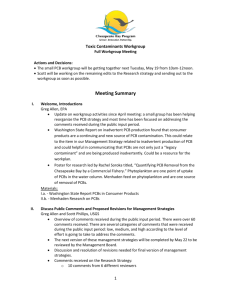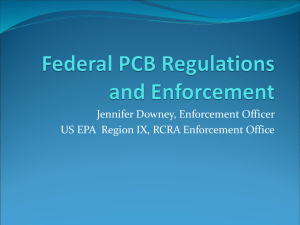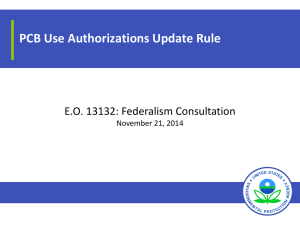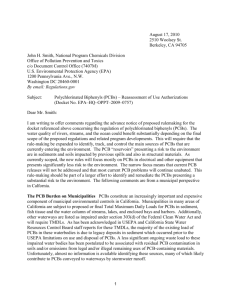fluorescent ballast questionnaire
advertisement
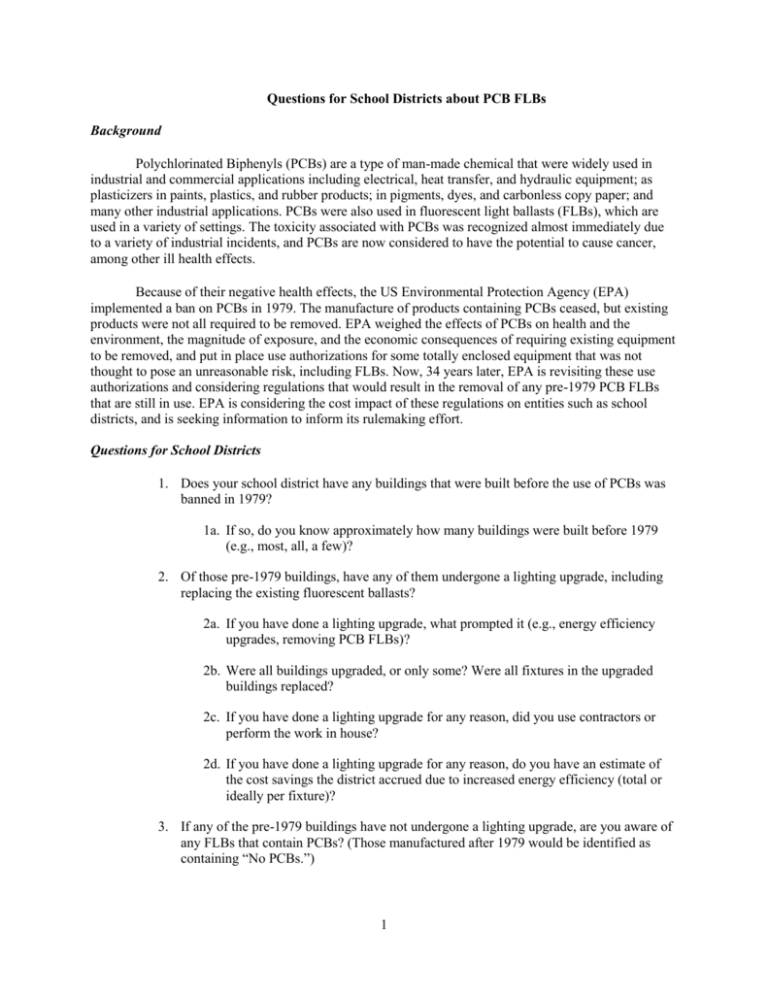
Questions for School Districts about PCB FLBs Background Polychlorinated Biphenyls (PCBs) are a type of man-made chemical that were widely used in industrial and commercial applications including electrical, heat transfer, and hydraulic equipment; as plasticizers in paints, plastics, and rubber products; in pigments, dyes, and carbonless copy paper; and many other industrial applications. PCBs were also used in fluorescent light ballasts (FLBs), which are used in a variety of settings. The toxicity associated with PCBs was recognized almost immediately due to a variety of industrial incidents, and PCBs are now considered to have the potential to cause cancer, among other ill health effects. Because of their negative health effects, the US Environmental Protection Agency (EPA) implemented a ban on PCBs in 1979. The manufacture of products containing PCBs ceased, but existing products were not all required to be removed. EPA weighed the effects of PCBs on health and the environment, the magnitude of exposure, and the economic consequences of requiring existing equipment to be removed, and put in place use authorizations for some totally enclosed equipment that was not thought to pose an unreasonable risk, including FLBs. Now, 34 years later, EPA is revisiting these use authorizations and considering regulations that would result in the removal of any pre-1979 PCB FLBs that are still in use. EPA is considering the cost impact of these regulations on entities such as school districts, and is seeking information to inform its rulemaking effort. Questions for School Districts 1. Does your school district have any buildings that were built before the use of PCBs was banned in 1979? 1a. If so, do you know approximately how many buildings were built before 1979 (e.g., most, all, a few)? 2. Of those pre-1979 buildings, have any of them undergone a lighting upgrade, including replacing the existing fluorescent ballasts? 2a. If you have done a lighting upgrade, what prompted it (e.g., energy efficiency upgrades, removing PCB FLBs)? 2b. Were all buildings upgraded, or only some? Were all fixtures in the upgraded buildings replaced? 2c. If you have done a lighting upgrade for any reason, did you use contractors or perform the work in house? 2d. If you have done a lighting upgrade for any reason, do you have an estimate of the cost savings the district accrued due to increased energy efficiency (total or ideally per fixture)? 3. If any of the pre-1979 buildings have not undergone a lighting upgrade, are you aware of any FLBs that contain PCBs? (Those manufactured after 1979 would be identified as containing “No PCBs.”) 1 3a. If you are aware of any PCB FLBs, do you have a sense of how what percentage of fixtures might contain PCB FLBs? 3b. If you are aware of any PCB FLBs, do you know if any of them are leaking (i.e., causing discoloration on the ballast or fixture)? If so, do you have a sense of what percentage might be leaking? 3c. If you are aware of any PCB FLBs, does the district have any plans to replace them? 4. Are you aware of the Department of Energy (DOE) Rule changing the efficiency requirements for fluorescent bulbs, making it difficult to find T12 bulbs that meet the requirements? If so, does the district have plans to upgrade old T12 fixtures for this reason? 4a. How does the procurement process work for fluorescent bulbs? Does the district buy them in bulk, or are individual schools responsible for that? Are you aware of any “stockpiling” of T12 bulbs in response to the DOE rule? 5. If you haven’t already done a lighting upgrade and EPA were to require school districts with pre-1979 buildings that haven’t undergone a lighting upgrade to find and replace all PCB FLBs, can you describe how you anticipate that process would work? For instance: 5a. Who would inspect the fixtures? Who would replace the fixtures? Would you use in-house employees, or hire a lighting contractor? 5b. Do you anticipate having problems scheduling the work around the school schedule? 5c. Do you have a sense of how long the process might take? 5d. Do you anticipate any particular obstacles in this process? 2
